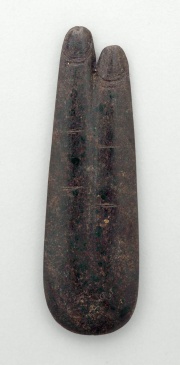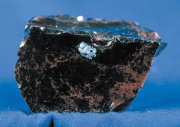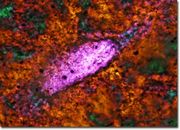Difference between revisions of "Obsidian"
| Line 1: | Line 1: | ||
[[File:57.521-CR8673-d1.jpg|thumb|Egyptian amulet<br>MFA# 57.521]] | [[File:57.521-CR8673-d1.jpg|thumb|Egyptian amulet<br>MFA# 57.521]] | ||
== Description == | == Description == | ||
| − | + | [[File:Obsidianemr1.jpg|thumb|Obsidian]] | |
| − | + | A dark,shiny glass formed in nature by the rapid cooling of lava. Obsidian is widely distributed and has been used since Paleolithic (before 3500 BCE) times for mirrors, weapons, tools, and jewelry. Sources of obsidian include Anatolia, Armenia, Ethiopia, Greece (Milos), Italy (Lipari, Eolie), Iceland, the U.S. (Wyoming), Mexico (Teotihuacan), Guatemala (Tikal), and Peru. Obsidian is often black in color but may also be yellow, red, brown or green. It produces conchoidal fractures when cleaved. Analysis of trace elements in obsidian pieces can be traced back to their original deposits. This has been used to evaluate early trading patterns. | |
| − | [[File:obsidiansnowflakelarge.jpg|thumb|Obsidian | + | [[File:obsidiansnowflakelarge.jpg|thumb|Obsidian thin section]] |
== Synonyms and Related Terms == | == Synonyms and Related Terms == | ||
volcanic glass; basalt glass; tachylite; perlite; calite; mountain mahogany (deep red obsidian); Apache tears (pebble-like nodules); obsidian snowflake (black with white inclusions); obsidiana (Esp., Port.); obsidienne (Fr.); Obsidian (Deut.); obsidiaan (Ned.) | volcanic glass; basalt glass; tachylite; perlite; calite; mountain mahogany (deep red obsidian); Apache tears (pebble-like nodules); obsidian snowflake (black with white inclusions); obsidiana (Esp., Port.); obsidienne (Fr.); Obsidian (Deut.); obsidiaan (Ned.) | ||
| − | |||
[[[SliderGallery rightalign|Obsidian (volcanic glass).TIF~FTIR (MFA)]]] | [[[SliderGallery rightalign|Obsidian (volcanic glass).TIF~FTIR (MFA)]]] | ||
== Physical and Chemical Properties == | == Physical and Chemical Properties == | ||
| Line 35: | Line 34: | ||
* ''Encyclopedia of Archaeology'', Glyn E. Daniel, ed., Thomas Y. Crowell Co., New York, 1977 | * ''Encyclopedia of Archaeology'', Glyn E. Daniel, ed., Thomas Y. Crowell Co., New York, 1977 | ||
* A.Lucas, J.R.Harris, ''Ancient Egyptian Materials and Industries'', Edward Arnold Publishers Ltd., London, 4th edition, 1962 | * A.Lucas, J.R.Harris, ''Ancient Egyptian Materials and Industries'', Edward Arnold Publishers Ltd., London, 4th edition, 1962 | ||
| − | * C.W.Chesterman, K.E.Lowe, ''Audubon Society Field Guide to North American Rocks and Minerals'', Alfred A. Knopf, New York, 1979 | + | * C.W.Chesterman, K.E.Lowe, ''Audubon Society Field Guide to North American Rocks and Minerals'', Alfred A. Knopf, New York, 1979; Mohs hardness = 6-7 |
* Wikipedia: [https://en.wikipedia.org/wiki/Obsidian Obsidian] (Accessed Nov. 9, 2005 and Dec 2022); Mohs hardness = 5-6 | * Wikipedia: [https://en.wikipedia.org/wiki/Obsidian Obsidian] (Accessed Nov. 9, 2005 and Dec 2022); Mohs hardness = 5-6 | ||
* George Savage, ''Art and Antique Restorer's Handbook'', Rockliff Publishing Corp, London, 1954 | * George Savage, ''Art and Antique Restorer's Handbook'', Rockliff Publishing Corp, London, 1954 | ||
| Line 41: | Line 40: | ||
* Random House, ''Webster's Encyclopedic Unabridged Dictionary of the English Language'', Grammercy Book, New York, 1997 | * Random House, ''Webster's Encyclopedic Unabridged Dictionary of the English Language'', Grammercy Book, New York, 1997 | ||
* ''The American Heritage Dictionary'' or ''Encarta'', via Microsoft Bookshelf 98, Microsoft Corp., 1998 | * ''The American Heritage Dictionary'' or ''Encarta'', via Microsoft Bookshelf 98, Microsoft Corp., 1998 | ||
| − | * ''CRC Handbook of Chemistry and Physics'', Robert Weast (ed.), CRC Press, Boca Raton, Florida, v. 61, 1980 | + | * ''CRC Handbook of Chemistry and Physics'', Robert Weast (ed.), CRC Press, Boca Raton, Florida, v. 61, 1980; ref. index=1.482-1.496 |
[[Category:Materials database]] | [[Category:Materials database]] | ||
Revision as of 15:52, 27 December 2022
Description
A dark,shiny glass formed in nature by the rapid cooling of lava. Obsidian is widely distributed and has been used since Paleolithic (before 3500 BCE) times for mirrors, weapons, tools, and jewelry. Sources of obsidian include Anatolia, Armenia, Ethiopia, Greece (Milos), Italy (Lipari, Eolie), Iceland, the U.S. (Wyoming), Mexico (Teotihuacan), Guatemala (Tikal), and Peru. Obsidian is often black in color but may also be yellow, red, brown or green. It produces conchoidal fractures when cleaved. Analysis of trace elements in obsidian pieces can be traced back to their original deposits. This has been used to evaluate early trading patterns.
Synonyms and Related Terms
volcanic glass; basalt glass; tachylite; perlite; calite; mountain mahogany (deep red obsidian); Apache tears (pebble-like nodules); obsidian snowflake (black with white inclusions); obsidiana (Esp., Port.); obsidienne (Fr.); Obsidian (Deut.); obsidiaan (Ned.)
Physical and Chemical Properties
- Transparent to translucent
- Luster = vitreous
- Fluorescence = generally inert
- Pleochroism = usually none
- Birefringence = none
- Inclusions = possible gas bubbles, stubby needles; banding
| Mohs Hardness | 5 - 7 |
|---|---|
| Density | 2.4 - 2.6 g/ml |
| Refractive Index | 1.482-1.496 |
Resources and Citations
- Gem Identification Lab Manual, Gemological Institute of America, 2016.
- G.S.Brady, Materials Handbook, McGraw-Hill Book Co., New York, 1971 Comment: p. 641
- Jack Odgen, Jewellery of the Ancient World, Rizzoli International Publications Inc., New York City, 1982
- Encyclopedia of Archaeology, Glyn E. Daniel, ed., Thomas Y. Crowell Co., New York, 1977
- A.Lucas, J.R.Harris, Ancient Egyptian Materials and Industries, Edward Arnold Publishers Ltd., London, 4th edition, 1962
- C.W.Chesterman, K.E.Lowe, Audubon Society Field Guide to North American Rocks and Minerals, Alfred A. Knopf, New York, 1979; Mohs hardness = 6-7
- Wikipedia: Obsidian (Accessed Nov. 9, 2005 and Dec 2022); Mohs hardness = 5-6
- George Savage, Art and Antique Restorer's Handbook, Rockliff Publishing Corp, London, 1954
- Van Nostrand's Scientific Encyclopedia, Douglas M. Considine (ed.), Van Nostrand Reinhold, New York, 1976
- Random House, Webster's Encyclopedic Unabridged Dictionary of the English Language, Grammercy Book, New York, 1997
- The American Heritage Dictionary or Encarta, via Microsoft Bookshelf 98, Microsoft Corp., 1998
- CRC Handbook of Chemistry and Physics, Robert Weast (ed.), CRC Press, Boca Raton, Florida, v. 61, 1980; ref. index=1.482-1.496



